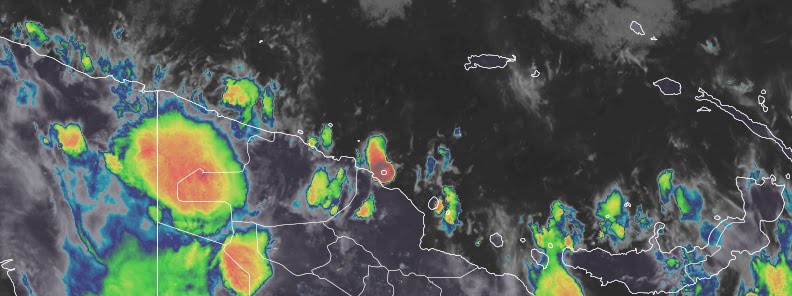High-level eruption at Manam volcano, P.N.G.

A high-level eruption started at Manam volcano, Papua New Guinea at 16:20 UTC on April 17, 2022.
According to the Darwin VAAC, volcanic ash was observed on RGB and Visible satellite imagery moving N and NW.
IR temperature of approximately -71 °C (95.8 °F) resulted in a height estimate of 13.7 km (45 000 feet).
The Aviation Color Code was raised to Red.1
Satellite imagery acquired at 05:40 UTC on April 18 indicated that ash from the volcano has dissipated.
There are no further reports of new or ongoing eruption, but the Aviation Color Code remains at Red, as of 06:30 UTC on April 18.
Several eruptions took place at Manam volcano, Papua New Guinea on March 8 and 9, 2022. The largest sent volcanic ash up to 15.2 km (50 000 feet) above sea level, drifting W and toward the main island.
- High-level eruption at Manam volcano, ash to 15 km (50 000 feet) a.s.l., P.N.G. – March 9, 2022
A series of high-level eruption were reported at the volcano beginning on December 8, 2018, and lasting through January 24, 2019:
- Destructive eruption at Manam volcano, residents call urgent evacuation, VA to 16.7 km (55 000 feet) a.s.l., P.N.G. – January 24, 2019
- High-impact eruption at Manam volcano, ash to 15.2 km (50 000 feet) a.s.l., Papua New Guinea – January 23, 2019
- High-level eruption at Manam volcano, ash to 15.2 km (50 000 feet) a.s.l., P.N.G. – January 11, 2019
- Powerful eruption at Manam volcano, ash to 16.7 km (55 000 feet) a.s.l., P.N.G. – January 08, 2019
- High-impact eruption at Manam volcano, heavy ashfall blocking sunlight, P.N.G. – December 08, 2018
Geological summary
The 10 km (6.2 miles) wide island of Manam, lying 13 km (8 miles) off the northern coast of mainland Papua New Guinea, is one of the country’s most active volcanoes. Four large radial valleys extend from the unvegetated summit of the conical 1 807 m (5 928 feet) high basaltic-andesitic stratovolcano to its lower flanks.
These “avalanche valleys” channel lava flows and pyroclastic avalanches that have sometimes reached the coast. Five small satellitic centers are located near the island’s shoreline on the northern, southern, and western sides.
Two summit craters are present; both are active, although most historical eruptions have originated from the southern crater, concentrating eruptive products during much of the past century into the SE valley.
Frequent historical eruptions, typically of mild-to-moderate scale, have been recorded since 1616. Occasional larger eruptions have produced pyroclastic flows and lava flows that reached flat-lying coastal areas and entered the sea, sometimes impacting populated areas.2
References:
1 Darwin VAAC – VAA – April 17, 2022
2 Manam – Geological summary – GVP
Featured image credit: JMA/Himawari-8, RAMMB/CIRA, TW


Commenting rules and guidelines
We value the thoughts and opinions of our readers and welcome healthy discussions on our website. In order to maintain a respectful and positive community, we ask that all commenters follow these rules.